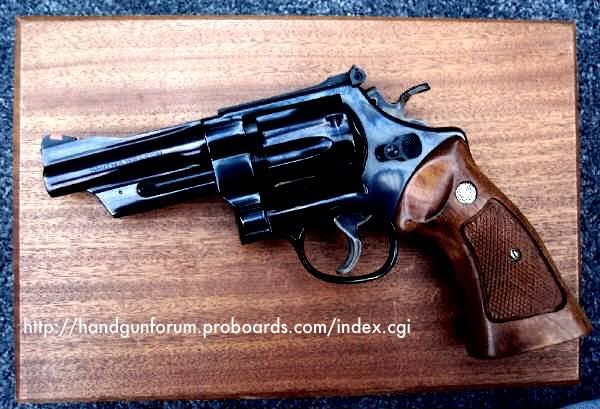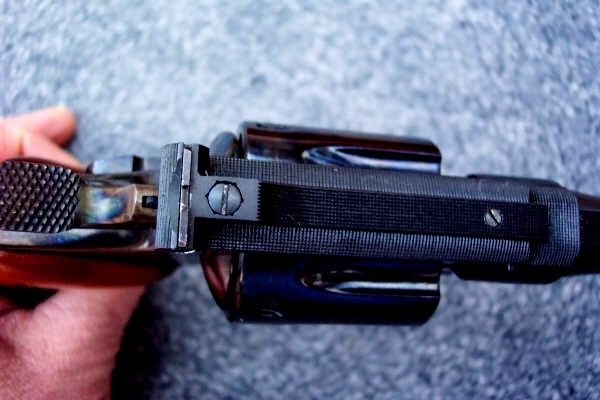Post by "DoubleAction" on Aug 15, 2004 18:44:31 GMT -5
..Aug 15, 2004 at 7:44pm : Today was the premier range session for my four inch Smith & Wesson, using the Georgia Arms factory loaded 125 gr., .357 Magnum, Jacketed Hollow Point cartridges. This was the first time this revolver has ever been fired, since leaving the factory during the 80's.
Last night I went through the gun, it's bore, cylinder, and trigger one last time before packing it for the range; The last thing I did was test the trigger with pull weights. After going through the weights on the trigger, I found the Double Action stroke to pull through in one single non-stacking 7 1/4 lbs. I went over and over with the weights to make sure this was right, and it turned out to be correct. The Python's factory trigger stroke stacks at about 8 lbs toward the end, and the Weigand Action pulls through at a little less than 8 lbs. I found myself realizing that what I was looking at was Smith & Wesson's Flagship of the .357 magnums, the successor to the Registered .357 magnum Revolver. The checkered top strap and high gloss blued finish only told me of the aesthetics of the gun. To proceed, from my jaw hanging ramblings, I packed it up in a rug and went to bed.
The next morning my brother arrived with two Custom Weigands, and one Performance Center Smith & Wesson revolvers. I took him to the back and showed him the pull weight on the Double Action Stroke; He was surprised also.
Range Time; After shooting everything else, it was time to shoot the 27. I took out the 27 and handed it to my brother, who had been shooting the double action revolvers for over an hour. I looked as his shot placements impacted with groups to within 1/2 to no more than 1 inch on the average, with many hits touching. This was without a bench rest at 17 yards, with a man in his fifties wearing bi-focals.
I often heard that the 27 will recoil a lot harder than some other revolvers; That might be dependent upon the ammunition, because I found this revolver to be very smooth, which I'll ramble about later.
I had put on a set of open backstrap rubber Hogues for the range, providing me with the grip I prefer. First time I squeezed the trigger, I felt a smoothness like no other revolver I have ever encountered except for my Python. I had a strong feeling that this was to be the gun that would give the Python a run for it's money, especially with it's shorter trigger stroke. Shooting 5 inch targets at 15 yards was pure child's play with this holy grail of double action revolvers; The trigger was so smooth and light, I often caught myself almost double tapping shots out. Not once did I have to adjust the sights for point of aim impact; I did try to bench rest it for 25 yds, but the bench and chair did not match up very well with height. No bad though; I was having the time of my life with the double action trigger and overall smoothness of the gun. This is a revolver that breathes "Shoot Me Alot", and it won't make one ashamed of where the bullets hit. If the bullets miss the ten ring, it's because of the shooter.
My recommendations for this Revolver is to get one before the price goes up, as it did with the Python. For the price,nothing will be as good or closer to Colt's Python, as the S&W Model 27-2. The big difference between the two guns are frame sizes, lock work, barrels, and other obvious differences. What you will get is a very proficient, expertly crafted, double action .357 magnum revolver which will make your shooting pleasure overwhelming during many years to come. These Model 27s are very strong N-Frame revolvers, and manufactured during a time when skilled fitters took part in their production. Even with factory reloads, they perform with flawless grace.
One other thing on the trigger; This Model 27 is a pure thorough bred Double Action Revolver, no matter how high or low you get on the backstrap, it continues to function smoothly in recoil and accuracy. I wish I could have the Python's barrel on a 27.


Last night I went through the gun, it's bore, cylinder, and trigger one last time before packing it for the range; The last thing I did was test the trigger with pull weights. After going through the weights on the trigger, I found the Double Action stroke to pull through in one single non-stacking 7 1/4 lbs. I went over and over with the weights to make sure this was right, and it turned out to be correct. The Python's factory trigger stroke stacks at about 8 lbs toward the end, and the Weigand Action pulls through at a little less than 8 lbs. I found myself realizing that what I was looking at was Smith & Wesson's Flagship of the .357 magnums, the successor to the Registered .357 magnum Revolver. The checkered top strap and high gloss blued finish only told me of the aesthetics of the gun. To proceed, from my jaw hanging ramblings, I packed it up in a rug and went to bed.
The next morning my brother arrived with two Custom Weigands, and one Performance Center Smith & Wesson revolvers. I took him to the back and showed him the pull weight on the Double Action Stroke; He was surprised also.
Range Time; After shooting everything else, it was time to shoot the 27. I took out the 27 and handed it to my brother, who had been shooting the double action revolvers for over an hour. I looked as his shot placements impacted with groups to within 1/2 to no more than 1 inch on the average, with many hits touching. This was without a bench rest at 17 yards, with a man in his fifties wearing bi-focals.
I often heard that the 27 will recoil a lot harder than some other revolvers; That might be dependent upon the ammunition, because I found this revolver to be very smooth, which I'll ramble about later.
I had put on a set of open backstrap rubber Hogues for the range, providing me with the grip I prefer. First time I squeezed the trigger, I felt a smoothness like no other revolver I have ever encountered except for my Python. I had a strong feeling that this was to be the gun that would give the Python a run for it's money, especially with it's shorter trigger stroke. Shooting 5 inch targets at 15 yards was pure child's play with this holy grail of double action revolvers; The trigger was so smooth and light, I often caught myself almost double tapping shots out. Not once did I have to adjust the sights for point of aim impact; I did try to bench rest it for 25 yds, but the bench and chair did not match up very well with height. No bad though; I was having the time of my life with the double action trigger and overall smoothness of the gun. This is a revolver that breathes "Shoot Me Alot", and it won't make one ashamed of where the bullets hit. If the bullets miss the ten ring, it's because of the shooter.
My recommendations for this Revolver is to get one before the price goes up, as it did with the Python. For the price,nothing will be as good or closer to Colt's Python, as the S&W Model 27-2. The big difference between the two guns are frame sizes, lock work, barrels, and other obvious differences. What you will get is a very proficient, expertly crafted, double action .357 magnum revolver which will make your shooting pleasure overwhelming during many years to come. These Model 27s are very strong N-Frame revolvers, and manufactured during a time when skilled fitters took part in their production. Even with factory reloads, they perform with flawless grace.
One other thing on the trigger; This Model 27 is a pure thorough bred Double Action Revolver, no matter how high or low you get on the backstrap, it continues to function smoothly in recoil and accuracy. I wish I could have the Python's barrel on a 27.





